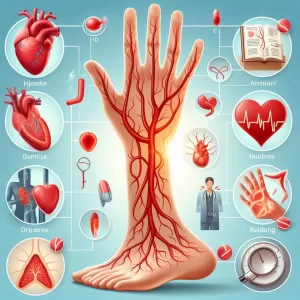What are Genital Warts?
Genital warts (condylomata acuminate or anogenital warts) are the most common sexually transmitted disease (STD) and a symptom of human papillomavirus (HPV) infection — a very common and highly contagious skin infection.
Although HPV comes in over 100 different types, 90 percent of all cases of genital warts are caused by strains 6 and 11.[1] Accordingly, only 10 percent of those who contract the virus will develop visible warts.
Even if they are unaware of its presence, most sexually active people will contract HPV at some point during their lifetime. It is passed on through skin-to-skin contact, most commonly through oral, vaginal, or anal intercourse.
Although warts rarely cause any long-term harm, they are generally considered unsightly and may cause psychological distress. There is no cure for genital warts or HPV, meaning treatment options are limited to managing the physical impact.
Symptoms of genital warts
Most people who contract HPV will not develop any visible symptoms. If genital warts do appear, it can sometimes be a significant amount of time – weeks or even months – after first contracting the infection.[2]
Genital warts generally form in clusters, though a single wart can also appear. They normally form on the outside of the body in the genital or anal area, typically on the vagina, labia majora, penile shaft or scrotum. They can also less commonly appear internally; inside the anus, the vagina, the opening of the urethra, or on the cervix.
Genital warts usually take the form of small bumps of roughly two to three centimeters in diameter and are sometimes described as resembling miniature cauliflowers. They typically cause no pain and minimal discomfort, are red or skin-colored in appearance and can be either soft or hard to touch. If scratched or excessively disturbed, a wart may bleed.
If you are concerned you may have genital warts or another sexually transmitted disease, contact your doctor.
Causes of genital warts
Human papillomavirus (HPV) causes genital warts. This is a skin infection that comes in over 100 different types, each affecting a different part of the body. There are roughly 30 types of HPV that can affect the genital and anal areas, but only two (6 and 11) cause the vast majority (90 percent) of all cases of genital warts. Both men and women can contract the virus and pass it on to others.
Transmission
Genital warts are spread through skin-to-skin contact, primarily through oral, vaginal, or anal sex.[3] Penetrative sex, however, is not necessary for contraction; close genital contact can be enough for HPV to be passed on between two sexual partners.
Although human papillomavirus (HPV) is extremely contagious, the infection cannot occur through such physical interactions as hugging or kissing, nor through items of clothing or towels. After HPV has been contracted, it is typical for genital warts to appear in between two weeks and eight months.[4]
Worried you may have contracted genital warts or another sexually transmitted disease? contact your doctor.
Latency and reappearance
HPV naturally clears from the body in two years or under in 90 percent of cases. For those who have developed genital warts and seen them disappear, there is a chance of warts recurring within, or in a small number of cases, outside of this timeframe.
Diagnosing genital warts
Most commonly, visible genital warts will be diagnosed through a routine doctor’s examination and the review of the patient’s medical history.
If, however, there is a suspicion of HPV infection without any visible symptoms, other diagnostic routes may be explored. For women, this will most often involve a gynecological exam and Pap test, followed by a tissue biopsy if abnormal cells are detected. Biopsies for men are far rarer and are generally not recommended by doctors.
Gynecological exam / Pap test
For women without visible genital warts, diagnosing the presence of HPV will often involve undergoing a gynecological exam. This exam will typically include a Pap test (sometimes called a Pap smear).[5] A procedure usually used to test for cervical cancer, the Pap test screens the cervix for abnormal cells, which are a possible sign of HPV infection. If abnormal cells are found on the cervix, further tests will be carried out to screen for HPV infection, as well as the presence of cervical cancer.
Genital warts treatment
There is no cure for genital warts – no way to remove HPV from the patient’s system – meaning that treatment is focused on removing warts or preventing them from spreading. The direction that treatment will take depends on the amount of warts present, their location, and their physical appearance.[6]
Some patients will choose to undergo no treatment for genital warts. This option is perfectly safe but will generally prolong the problem. If the patient does opt for treatment, there are a number of different options to explore:
- Application of antiviral gels or creams. These solutions are marketed in a number of different varieties but are generally applied by the patient themselves over the course of a number of days or weeks. Side-effects may include itching and mild scarring.
- Cryotherapy (freezing). Liquid nitrogen is used to rapidly freeze the affected area, resulting in a mild burning sensation. This procedure is usually used for small warts around the penis or vulva.
- Excision. The warts are surgically removed while the patient is under a local anesthetic. Typically used for small, hardened warts.
- Electrosurgery. Generally used for large clusters of warts that have not responded to other treatments, this option involves cutting away the bulk of the warts, pressing a metal rod against the affected area and sending an electric current through it to burn away what remains.
- Laser surgery. Generally used for large clusters of warts or those that are difficult to reach (inside the anus, for example). A specialist will use a laser to burn away the mass of warts while the patient is under regional or general anaesthetic.
Prevention of genital warts
Although they are not 100 percent reliable, the use of condoms remains the most effective way of preventing the contraction of genital warts. There are also HPV vaccines available. These vaccines do not protect against all strains of HPV but may be effective in preventing genital warts.
Condoms
To help protect against genital warts, condoms should be used every time vaginal, anal or oral intercourse is engaged in. Apart from celibacy, this is the most effective prevention method currently known of. However, using a condom does not guarantee full protection. The virus may be able to spread from genital skin not covered by the condom.
Vaccines
An HPV vaccine can be effective in preventing genital warts, as well as other conditions including cervical cancer. These vaccines are most effective if given before a young person becomes sexually active and are usually given between 11 and 13 years of age. Catch-up programs are sometimes available up to the age of 26, but vaccination in people over 26 has been shown to be ineffective.[7]
There are a number of vaccines available (Gardasil and Cervarix, for example), each protecting against a number of different HPV strains. No vaccine is able to protect against all strains of HPV, nor guarantee defense against all types of genital warts. However, vaccination does significantly lower one’s chances of contracting HPV.
The HPV virus and cancer
The human papillomavirus (HPV) that causes genital warts can also cause several forms of cancers, including:[8]
- Cervical cancer. Most cases of cervical cancer are caused by HPV. Strains 16 and 18 are responsible for roughly 70 percent of all cases. The HPV vaccination protects against 70 percent of the HPV strains that cause cervical cancer, meaning that it is effective in preventing the condition but not guaranteed.
- Anal cancer: An estimated 95 percent of all cases of anal cancer are caused by HPV, with most of these caused by type 16.
- Oropharyngeal cancer: Roughly 70 percent of oropharyngeal cancers (cancers of the middle throat) are caused by HPV.
- Other forms of cancer: Penile, vulvar and vaginal cancers can also be caused by HPV, with type 16 responsible for most cases.
Good to know: A weakened immune system, smoking tobacco, giving birth to a large number of children and poor oral hygiene can all increase one’s risk of developing HPV-linked cancer.
Genital warts FAQs
u003cstrongu003eShould sexual intercourse be avoided when genital warts are present?u003c/strongu003e
Yes. HPV is highly contagious, meaning sexual intercourse should be avoided to prevent the passing of the virus. If this is not possible, a condom should be worn.
u003cstrongu003eGenital warts during pregnancy — should I be worried?u003c/strongu003e
Generally, no. It is unlikely that HPV will be passed from mother to babyu003cbru003ebefore or during childbirth.
u003cstrongu003eCan genital warts be contracted from oral sex?u003c/strongu003e
Yes. To prevent the spread of genital warts through oral sex, a condom should be worn at all times.
u003cstrongu003eCan genital warts cause cancer?u003c/strongu003e
While genital warts themselves cannot be said to cause cancer, some strains of the HPV virus can cause certain types of cancer. u003ca href=u0022https://adoctor.org/conditions/cervical-cancer/u0022u003eCervical canceru003c/au003e and u003ca href=u0022https://adoctor.org/conditions/anal-cancer/u0022u003eanal canceru003c/au003e are often linked to HPV infection.
Other names for genital warts
- Anogenital warts
- Condyloma acuminatum
- Condylomata acuminata
-
NHS Choices. “Genital Warts – Symptoms.” August 22, 2017. Accessed June 23, 2017. ↩
-
DrEd. “Early Signs of Genital Warts.” Accessed June 23, 2017. ↩
-
In the know ZONE. “How are genital warts spread.” Accessed June 23, 2017. ↩
-
NCBI. “Genital HPV infection and related lessons in men.” October, 2011. Accessed June 23, 2017. ↩
-
WebMD. “Genital Warts.” Accessed June 26, 2017. ↩
-
fpa. “Genital Warts.” July, 2014. Accessed June 26, 2017. ↩
-
CDC. “HPV Vaccination Information for Young Women.” December 28, 2016. Accessed June 26, 2017. ↩
-
National Cancer Institute. “HPV and Cancer.” Accessed July 11, 2017. ↩
**Q: What are Genital Warts?**
**A:** Genital warts are a common sexually transmitted infection (STI) caused by the human papillomavirus (HPV). They appear as small, fleshy, cauliflower-like growths on or around the genitalia.
**Keywords:** Genital Warts, HPV, STI, Sexually Transmitted Infection, Genitalia
**Q: How are Genital Warts Transmitted?**
**A:** Genital HPV is primarily transmitted through direct skin-to-skin contact during vaginal, anal, or oral sex. It can also be transmitted by sharing sex toys or touching infected warts.
**Keywords:** Transmission, HPV, Skin-to-Skin Contact, Vaginal Sex, Anal Sex, Oral Sex, Sex Toys
**Q: What are the Symptoms of Genital Warts?**
**A:** Genital warts typically develop within 2-3 months after infection. They may appear as:
* Small, fleshy, cauliflower-like growths on or around the genitals, anus, or mouth
* Warts that are flat or raised
* Warts that are multiple or clustered
* Warts that can be itchy or painful
**Keywords:** Symptoms, Growths, Cauliflower-like, Genitals, Anus, Mouth, Itchy, Painful
**Q: How are Genital Warts Diagnosed?**
**A:** Genital warts are usually diagnosed through a physical examination by a healthcare provider. In some cases, a biopsy may be performed to confirm the diagnosis.
**Keywords:** Diagnosis, Physical Examination, Biopsy
**Q: What are the Treatment Options for Genital Warts?**
**A:** Treatment options for genital warts include:
* Topical medications: Imiquimod, podophyllin, and trichloroacetic acid
* Cryotherapy: Freezing the warts with liquid nitrogen
* Electrosurgery: Using an electrical current to burn off the warts
* Laser therapy: Using a laser beam to vaporize the warts
**Keywords:** Treatment, Topical Medications, Cryotherapy, Electrosurgery, Laser Therapy
**Q: How Can Genital Warts be Prevented?**
**A:** Genital HPV can be prevented through:
* Vaccination: The HPV vaccine is available for both males and females and can protect against the strains of HPV that cause most genital warts.
* Condom Use: Using a condom during every sexual encounter can reduce the risk of transmission.
* Limiting Sexual Partners: Having fewer sexual partners can decrease the risk of contracting HPV.
**Keywords:** Prevention, HPV Vaccine, Condom Use, Limiting Sexual Partners
Popular Articles







